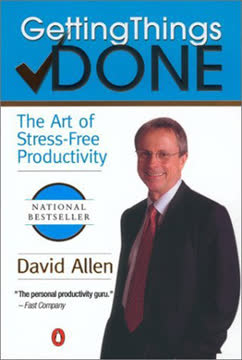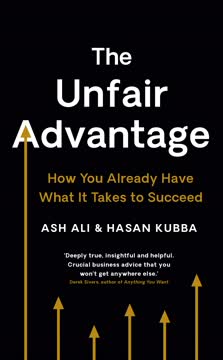نکات کلیدی
1. تسلط بر قانون سهگانه برای افزایش تمرکز و بهرهوری
قانون سهگانه به شما کمک میکند تا بر روی چند مورد حیاتی که اهمیت دارند، متمرکز بمانید.
سادهسازی و اولویتبندی. قانون سهگانه سنگ بنای نتایج چابک است و شما را تشویق میکند تا سه نتیجه کلیدی برای روز، هفته، ماه و سال خود شناسایی کنید. این روش به شما کمک میکند تا از شلوغی فهرستهای بیپایان کارها عبور کنید و بر روی آنچه واقعاً مهم است تمرکز کنید. با محدود کردن تمرکز خود به سه مورد، احساس سردرگمی را کاهش داده و شانس دستیابی به اهداف خود را افزایش میدهید.
انعطافپذیری و شروعهای تازه. هر روز فرصتی جدید برای بهکارگیری قانون سهگانه فراهم میکند و به شما این امکان را میدهد که به اولویتها و شرایط متغیر سازگار شوید. این انعطافپذیری اطمینان میدهد که همیشه بر روی مهمترین وظایف کار میکنید و به فهرستهای قدیمی وابسته نیستید. قانون سهگانه بهخوبی مقیاسپذیر است:
- روزانه: سه نتیجه برای هدایت اقدامات شما
- هفتگی: سه نتیجه کلیدی برای شکلدهی به تمرکز شما
- ماهانه: سه هدف برای پیشبرد
- سالانه: سه دستاورد مهم برای آرزو کردن
2. پیادهسازی الگوی چشمانداز دوشنبه، نتایج روزانه، و بازتاب جمعه
الگوی چشمانداز دوشنبه، نتایج روزانه، و بازتاب جمعه یک الگوی ساده اما مؤثر برای دستیابی به نتایج است.
ساختاردهی به هفتهتان. این الگو ریتمی برای هفته شما فراهم میکند و اطمینان میدهد که با وضوح شروع میکنید، تمرکز را حفظ میکنید و با بازتاب به پایان میرسانید:
- چشمانداز دوشنبه: تعیین سه نتیجه کلیدی برای هفته
- نتایج روزانه: شناسایی سه نتیجه برای دستیابی در هر روز
- بازتاب جمعه: مرور آنچه خوب پیش رفت و زمینههای بهبود
بهبود مستمر. با آغاز و پایان هفتهتان با تعیین چشمانداز و بازتاب، یک حلقه بازخورد ایجاد میکنید که به شما اجازه میدهد رویکرد خود را بهطور مداوم اصلاح کنید. نتایج روزانه شما را در مسیر نگه میدارد، در حالی که مرور هفتگی به شما کمک میکند از تجربیات خود بیاموزید و استراتژیهای خود را متناسب با آن تنظیم کنید.
3. تعادل زندگی از طریق نقاط داغ: ذهن، بدن، احساسات، شغل، مالی، روابط، سرگرمی
نقاط داغ به شما کمک میکنند تا بر روی چیزهای مهم تمرکز کنید.
رویکرد جامع به زندگی. چارچوب نقاط داغ شما را تشویق میکند تا زمان و انرژی خود را در هفت حوزه کلیدی زندگی سرمایهگذاری کنید: ذهن، بدن، احساسات، شغل، مالی، روابط و سرگرمی. این رویکرد متعادل اطمینان میدهد که در حین پیگیری موفقیت در دیگر حوزهها، جنبههای مهم زندگی خود را نادیده نمیگیرید.
تعیین مرزها و تخصیص منابع. از نقاط داغ برای:
- شناسایی حوزههایی که نیاز به توجه بیشتری دارند
- تعیین حداقل و حداکثر زمان سرمایهگذاری برای هر حوزه
- ایجاد یک "نقشه حرارتی" بصری از زندگیتان برای هدایت تصمیمگیری
- شناسایی ارتباط متقابل این حوزهها و چگونگی حمایت از یکدیگر استفاده کنید
4. اولویتبندی نتایج به جای فعالیتها برای دستیابی به نتایج معنادار
نتایج، دستاوردهایی هستند که میخواهید به آنها برسید.
تمرکز بر تأثیر. ذهنیت خود را از صرفاً انجام وظایف به دستیابی به نتایج معنادار تغییر دهید. این رویکرد به شما کمک میکند:
- روشن کنید که موفقیت چگونه به نظر میرسد
- تصمیمات بهتری درباره اینکه کجا زمان و انرژی خود را سرمایهگذاری کنید، بگیرید
- از کارهای بیفایده که به اهداف شما کمک نمیکند، اجتناب کنید
همراستایی اقدامات روزانه با اهداف بزرگتر. با تمرکز بر نتایج، خط روشنی بین فعالیتهای روزانه و اهداف بلندمدت خود ایجاد میکنید. این همراستایی به حفظ انگیزه کمک میکند و اطمینان میدهد که تلاشهای شما به پیشرفت معنادار منجر میشود.
5. پذیرش ذهنیت رشد و استقبال از یادگیری مداوم
ذهنیت خود را تغییر دهید تا تغییر را بپذیرید.
پرورش تابآوری. ذهنیت رشد به این باور اشاره دارد که تواناییها و هوش شما میتوانند از طریق تلاش، یادگیری و پایداری توسعه یابند. این ذهنیت برای:
- غلبه بر چالشها و موانع
- استقبال از فرصتهای جدید برای یادگیری و رشد
- سازگاری با تغییرات در محیط شما ضروری است
استراتژیهای بهبود مستمر:
- شکستها را به عنوان فرصتهای یادگیری در نظر بگیرید
- بازخورد بگیرید و بر اساس آن عمل کنید
- اهداف چالشبرانگیزی تعیین کنید که تواناییهای شما را به چالش بکشند
- از ناراحتی یادگیری مهارتهای جدید استقبال کنید
6. بهرهبرداری از زمان، انرژی و تکنیک برای عملکرد بهینه
بهترین نتایج شما در تقاطع زمان، انرژی و تکنیکهای شما خواهد بود.
بهینهسازی منابع خود. درک کنید که بهرهوری تنها به مدیریت زمان مربوط نمیشود، بلکه به:
- مدیریت انرژی: شناسایی ساعات اوج عملکرد خود و هماهنگسازی وظایف مهم با آن
- بهبود تکنیک: بهطور مداوم روشها و رویکردهای خود را بهبود دهید
تخصیص استراتژیک. این عوامل را هنگام برنامهریزی کار خود در نظر بگیرید:
- زمان: از زمانبندی استفاده کنید و مرزهای روشنی تعیین کنید
- انرژی: وظایف با تأثیر بالا را در "ساعات قدرت" خود برنامهریزی کنید
- تکنیک: در یادگیری و بهبود روشهای مؤثر برای وظایف رایج سرمایهگذاری کنید
7. پرورش انگیزه از طریق "چراهای" جذاب و ذهنیتهای مثبت
اشتیاق سوخت شماست.
استفاده از انگیزه درونی. یک "چرا" جذاب برای اهداف و پروژههای خود توسعه دهید. این انگیزه درونی به شما کمک میکند:
- در چالشها پایدار بمانید
- در تصمیمگیریها وضوح بیشتری داشته باشید
- رضایت و مشارکت کلی خود را افزایش دهید
استراتژیهای ذهنیت مثبت:
- چالشها را به عنوان فرصتهای رشد بازتعریف کنید
- از استعارههای توانمندساز برای توصیف کار و زندگی خود استفاده کنید
- شکرگزاری کنید و پیروزیهای کوچک را جشن بگیرید
- خود را در میان افراد حمایتکننده و الهامبخش قرار دهید
8. طراحی روز، هفته، ماه و سال خود برای موفقیت پایدار
طراحی روز شما یک تمرین ساده در ایجاد زیرساخت کافی برای روزتان است.
برنامهریزی عمدی. کنترل زمان خود را با طراحی:
- روز: با یک چشمانداز واضح از سه نتیجه کلیدی خود شروع کنید
- هفته: از الگوی چشمانداز دوشنبه، نتایج روزانه، و بازتاب جمعه استفاده کنید
- ماه: اهداف وسیعتری تعیین کنید و بهطور منظم پیشرفت را مرور کنید
- سال: سه دستاورد مهم را شناسایی کنید که به سمت آنها کار کنید
ایجاد روالهای حمایتی. توسعه دهید:
- یک روال شروع برای آغاز روزتان با تمرکز و انرژی
- یک روال پایان برای انتقال مؤثر از کار به زمان شخصی
- جلسات مرور و برنامهریزی منظم برای ماندن در مسیر
9. استفاده از سوالات متمرکز بر راهحل برای غلبه بر چالشها
سوالات متمرکز بر راهحل به پیدا کردن راهی به جلو کمک میکنند.
تغییر دیدگاه. به جای ماندن بر روی مشکلات، خود را آموزش دهید تا سوالاتی بپرسید که به راهحلها منجر شود:
- "بهترین کار بعدی که میتوانم انجام دهم چیست؟"
- "چگونه میتوانم از این وضعیت بیشترین بهره را ببرم؟"
- "موفقیت در این سناریو چگونه به نظر میرسد؟"
رویکرد حل مسئله:
- نتیجه مطلوب را بهوضوح تعریف کنید
- راهحلهای ممکن را بدون قضاوت ایدهپردازی کنید
- گزینهها را بر اساس قابلیت اجرا و تأثیر ارزیابی کنید
- بهترین راهحل را انتخاب و اجرا کنید
- در صورت نیاز مرور و تنظیم کنید
10. بهرهبرداری از قدرت استعارهها و ذهنیتها برای شکلدهی به تجربهتان
استعارهها تجربه شما را شکل میدهند.
انتخاب مدلهای ذهنی توانمندساز. استعارهها و ذهنیتهایی که انتخاب میکنید بهطور قابل توجهی بر افکار، احساسات و اقدامات شما تأثیر میگذارند. بهطور آگاهانه انتخاب کنید:
- استعارههایی که شما را الهام میبخشند و انگیزه میدهند
- ذهنیتهایی که رشد و تابآوری را ترویج میدهند
کاربردهای عملی:
- چالشها را بازتعریف کنید: "این یک عقبنشینی نیست، بلکه یک راهاندازی برای بازگشت است"
- تفکر مبتنی بر نقش را بپذیرید: "من کارگردان داستان زندگیام هستم"
- از استعارههای الهامگرفته از طبیعت استفاده کنید: "من طوفان را پشت سر میگذارم" یا "من بذرهای موفقیت آینده را میکارم"
- بین "کلاهها" یا شخصیتهای مختلف جابهجا شوید تا وظایف مختلف را بهطور مؤثر انجام دهید
آخرین بهروزرسانی::
FAQ
1. What is "Getting Results the Agile Way" by J.D. Meier about?
- Personal Results System: The book introduces Agile Results, a personal productivity system designed to help individuals achieve meaningful results in work and life.
- Agility and Adaptability: It emphasizes adaptability, enabling readers to respond effectively to change rather than being managed by it.
- Outcome-Focused Approach: The system prioritizes outcomes over activities, encouraging readers to focus on what truly matters rather than just being busy.
- Holistic Life Balance: Agile Results integrates principles from productivity, project management, positive psychology, and agile software development to help readers balance work, personal life, and well-being.
2. Why should I read "Getting Results the Agile Way" by J.D. Meier?
- Simple, Actionable Framework: The book offers a straightforward, easy-to-implement system that can be adopted in under five minutes and tailored to individual needs.
- Work-Life Balance: It provides practical tools for achieving sustainable results while maintaining balance across key life areas like mind, body, emotions, career, finances, relationships, and fun.
- Continuous Improvement: Readers learn how to continuously improve their productivity and effectiveness through reflection and incremental changes.
- Proven in Real-World Scenarios: The system has been tested in high-pressure environments, including Microsoft, and is designed to scale for both individuals and teams.
3. What are the key takeaways from "Getting Results the Agile Way"?
- The Rule of 3: Focus on three key outcomes each day, week, month, and year to maintain clarity and avoid overwhelm.
- Monday Vision, Daily Outcomes, Friday Reflection: Use this weekly pattern to set intentions, prioritize daily actions, and reflect on progress for continuous improvement.
- Hot Spots: Identify and invest in the most important areas of your life to achieve balance and maximize results.
- Emphasis on Energy and Technique: Managing energy and using effective techniques are as important as managing time for achieving results.
4. How does the Agile Results system by J.D. Meier differ from other productivity systems?
- Agility Over Rigidity: Unlike static systems, Agile Results is designed to be flexible and responsive to change, allowing for course corrections as needed.
- Outcomes Over Activities: The system shifts focus from checking off tasks to achieving meaningful results, ensuring efforts align with personal and professional goals.
- Time as a First-Class Citizen: It encourages fixing time and flexing scope, rather than endlessly expanding work hours to get more done.
- Fresh Start Philosophy: Agile Results offers a fresh start each day, week, month, and year, making it easy to recover from setbacks and maintain momentum.
5. What is "The Rule of 3" in "Getting Results the Agile Way" and how do I use it?
- Core Practice: The Rule of 3 is the foundational practice of Agile Results, guiding you to identify three key outcomes for each day, week, month, and year.
- Clarity and Focus: By limiting your focus to three priorities, you avoid overwhelm and ensure attention is given to what matters most.
- Scalable Application: The Rule of 3 can be applied at different levels—daily, weekly, monthly, yearly—to maintain perspective and alignment.
- Incremental Progress: Once your three outcomes are achieved, you can always take on more, but the system encourages starting with a manageable scope.
6. What is the "Monday Vision, Daily Outcomes, Friday Reflection" pattern in Agile Results?
- Weekly Rhythm: On Mondays, set your vision by identifying three key outcomes for the week; each day, choose three outcomes to focus on; on Fridays, reflect on what went well and what needs improvement.
- Self-Correcting System: This pattern provides regular opportunities for course correction, learning, and adaptation.
- Reduces Overwhelm: By focusing on a small set of priorities, you avoid long, unmanageable to-do lists and stay engaged with your goals.
- Builds Momentum: The routine helps you build habits, maintain motivation, and celebrate progress, making it easier to sustain results over time.
7. What are "Hot Spots" in "Getting Results the Agile Way" and how do they help with work-life balance?
- Key Life Areas: Hot Spots are the most important areas of your life—mind, body, emotions, career, financial, relationships, and fun—that require your attention and investment.
- Personal Heat Map: They act as a heat map, helping you quickly identify opportunities and pain points across your life.
- Portfolio Approach: By viewing your life as a portfolio of Hot Spots, you can allocate time and energy more thoughtfully, avoiding over-investment in one area at the expense of others.
- Setting Boundaries: Hot Spots help you set minimums and maximums for each area, supporting sustainable work-life balance and preventing burnout.
8. What are the 10 values, 10 principles, and 12 core practices of Agile Results?
- 10 Values: These include Action over Analysis Paralysis, Energy over Time, Focus over Quantity, Good Enough over Perfection, Growth Mindset over Fixed Mindset, and more, guiding decision-making and trade-offs.
- 10 Principles: Principles such as 80/20 Action, Change Your Approach, Continuous Learning, Deliver Incremental Value, and Fix Time, Flex Scope provide foundational guidelines for behavior.
- 12 Core Practices: Practices like The Rule of 3, Monday Vision/Daily Outcomes/Friday Reflection, Scannable Outcomes, Strong Week, Timebox Your Day, and Growth Mindset translate values and principles into daily action.
- Flexible Adoption: You can adopt these practices incrementally, tailoring the system to your needs and context.
9. How do I design my day, week, month, and year using Agile Results?
- Day: Start with The Rule of 3 to set three outcomes, create a startup routine, scan your Hot Spots, and end with reflection.
- Week: Use Monday Vision to set weekly outcomes, consolidate strengths and weaknesses, schedule free time, and reflect on Fridays.
- Month: Map out your month at a glance, prioritize outcomes using MUST, SHOULD, COULD, and assign top priorities to each week.
- Year: Identify three great results or "wishes" for the year, create a scannable year-at-a-glance, and align monthly and weekly outcomes to support your annual goals.
10. What are the most common productivity pitfalls and personas described in "Getting Results the Agile Way"?
- Productivity Pitfalls: Common pitfalls include analysis paralysis, perfectionism, lack of boundaries, doing it only when you feel like it, and not knowing the work to be done.
- 30 Pitfalls Listed: The book details 30 pitfalls, such as burnout, blamer/victim mentality, lack of buffer, and watching the scoreboard instead of focusing on actions.
- Productivity Personas: Personas like Starter, Finisher, Thinker, Doer, Simplifier, Maximizer, Perfectionist, and Procrastinator help you understand your own and others' behavior patterns.
- Self-Awareness Tool: Recognizing these pitfalls and personas enables you to make better choices, team up effectively, and avoid common traps.
11. What are the 25 keys and 25 strategies for results in "Getting Results the Agile Way"?
- 25 Keys: These are foundational concepts such as Results over Productivity, Approach over Results, Value is in the Eye of the Beholder, Time/Energy/Technique, and Above the Line vs. Below the Line work.
- 25 Strategies: Strategies include Outcomes over Activities, Treat Time as a Valuable Resource, Fix Time/Flex Scope, Diversify Your Results, Make It a Project, Have a Strong Week, and Enjoy the Process.
- Actionable Guidance: Each key and strategy provides practical advice for improving effectiveness, efficiency, and personal satisfaction.
- Mix and Match: Readers are encouraged to familiarize themselves with these and draw on them as needed to overcome challenges and achieve goals.
12. What are the best quotes from "Getting Results the Agile Way" by J.D. Meier and what do they mean?
- "Notice that the stiffest tree is most easily cracked, while the bamboo or willow survives by bending with the wind." —Bruce Lee: Emphasizes the importance of adaptability and flexibility in achieving results.
- "You see, in life, lots of people know what to do, but few people actually do what they know. Knowing is not enough! You must take action." —Tony Robbins: Highlights the value of action over mere knowledge or planning.
- "Efficiency is doing things right; effectiveness is doing the right things." —Peter Drucker: Stresses the need to focus on meaningful outcomes rather than just being busy.
- "The best way to predict the future is to create it." —Peter Drucker: Encourages proactive goal-setting and intentional living, core themes of Agile Results.
- "Absorb what is useful. Discard what is not. Add what is uniquely your own." —Bruce Lee: Reflects the book’s encouragement to tailor the system to your unique needs and context.
نقد و بررسی
کتاب نتایج گرفتن به روش چابک نظرات متفاوتی دریافت میکند. برخی از خوانندگان آن را برای افزایش بهرهوری مفید میدانند و از مفاهیمی مانند قانون ۳ و چشمانداز دوشنبه، نتایج روزانه و بازتاب جمعه تمجید میکنند. دیگران از تکراری بودن و استفاده از اصطلاحات شرکتی آن انتقاد میکنند. این کتاب به عنوان یک سیستم انعطافپذیر برای تعادل بین زندگی و کار دیده میشود، اما برخی آن را گیجکننده یا تکراری میدانند. نظرات مثبت به توصیههای عملی و رویکرد هدفمحور آن اشاره دارند، در حالی که نظرات منفی به ویرایش ضعیف و کمبود اصالت اشاره میکنند. به طور کلی، این کتاب برای کسانی که تازه با سیستمهای بهرهوری آشنا میشوند توصیه میشود، اما ممکن است برای کاربران با تجربه چیز جدیدی ارائه ندهد.
Similar Books













